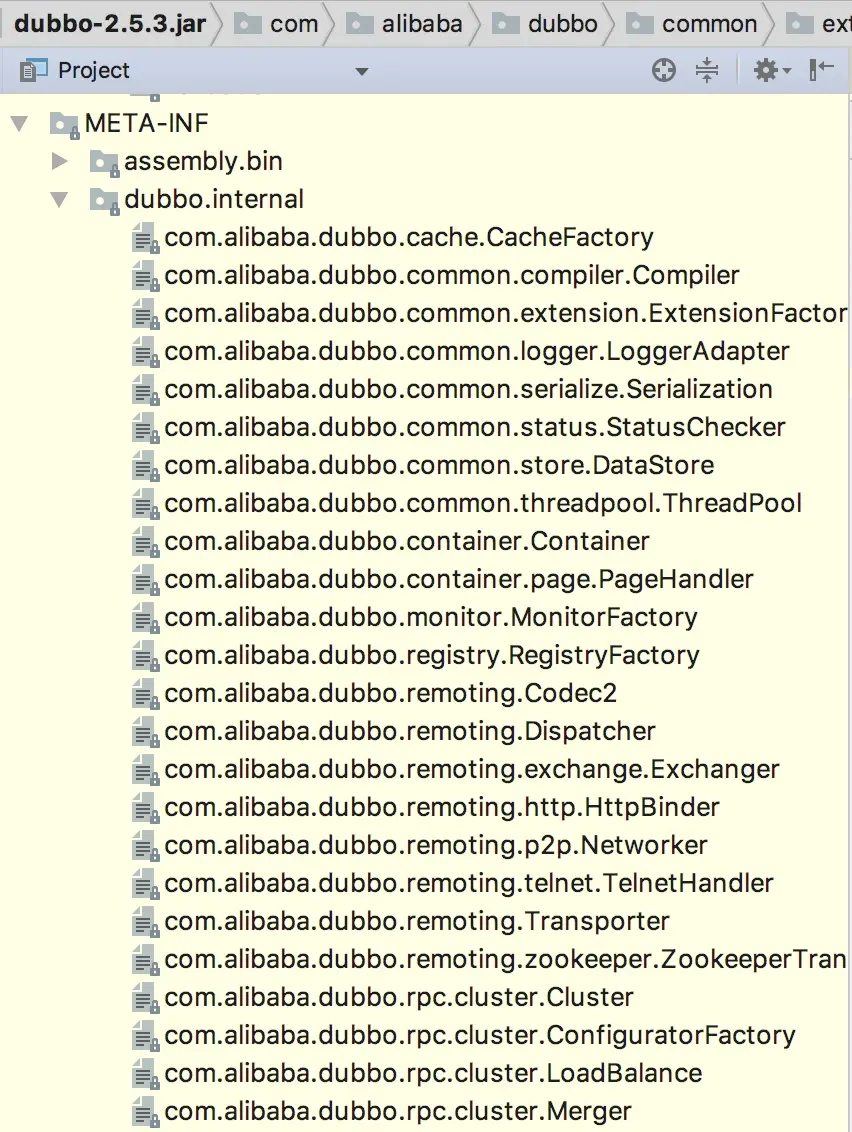JDK的SPI机制的缺点
⽂件中的所有类都会被加载且被实例化。这样也就导致获取某个实现类的方式不够灵活,只能通过 Iterator 形式获取,不能根据某个参数来获取对应的实现类。如果不想用某些实现类,或者某些类实例化很耗时,它也被载入并实例化了,没有办法指定某⼀个类来加载和实例化,这就造成了浪费。
此时dubbo的SPI可以解决
dubbo的SPI机制
dubbo⾃⼰实现了⼀套SPI机制来解决Java的SPI机制存在的问题。
dubbo中则采用了类似kv对的样式,在具体使用的时候则通过相关想法即可获取,而且获取的文件路径也不一致
ExtensionLoader 类文件
private static final String SERVICES_DIRECTORY = "META-INF/services/";
private static final String DUBBO_DIRECTORY = "META-INF/dubbo/";
private static final String DUBBO_INTERNAL_DIRECTORY = DUBBO_DIRECTORY + "internal/";如上述代码片段可知,dubbo是支持从META-INF/dubbo/,META-INF/dubbo/internal/以及META-INF/services/三个文件夹的路径去获取spi配置
例如com.alibaba.dubbo.rpc.Protocol 文件内容
registry=com.alibaba.dubbo.registry.integration.RegistryProtocol
filter=com.alibaba.dubbo.rpc.protocol.ProtocolFilterWrapper
listener=com.alibaba.dubbo.rpc.protocol.ProtocolListenerWrapper
mock=com.alibaba.dubbo.rpc.support.MockProtocol
injvm=com.alibaba.dubbo.rpc.protocol.injvm.InjvmProtocol
dubbo=com.alibaba.dubbo.rpc.protocol.dubbo.DubboProtocol
rmi=com.alibaba.dubbo.rpc.protocol.rmi.RmiProtocol
hessian=com.alibaba.dubbo.rpc.protocol.hessian.HessianProtocol
com.alibaba.dubbo.rpc.protocol.http.HttpProtocol
com.alibaba.dubbo.rpc.protocol.webservice.WebServiceProtocol
thrift=com.alibaba.dubbo.rpc.protocol.thrift.ThriftProtocol
memcached=memcom.alibaba.dubbo.rpc.protocol.memcached.MemcachedProtocol
redis=com.alibaba.dubbo.rpc.protocol.redis.RedisProtocol不过观察上述文件会发现,HttpProtocol是没有对应的k值,那就是说无法通过kv对获取到其协议实现类。后面通过源码可以发现,如果没有对应的name的时候,dubbo会通过findAnnotationName方法获取一个可用的name
Dubbo SPI 使用 & 源码学习
通过获取协议的代码来分析下具体的操作过程
Protocol 获取
Protocol protocol = ExtensionLoader.getExtensionLoader(Protocol.class).getAdaptiveExtension();
public static <T> ExtensionLoader<T> getExtensionLoader(Class<T> type) {
// 静态方法,意味着可以直接通过类调用
if (type == null)
throw new IllegalArgumentException("Extension type == null");
if(!type.isInterface()) {
throw new IllegalArgumentException("Extension type(" + type + ") is not interface!");
}
if(!withExtensionAnnotation(type)) {
throw new IllegalArgumentException("Extension type(" + type +
") is not extension, because WITHOUT @" + SPI.class.getSimpleName() + " Annotation!");
}
ExtensionLoader<T> loader = (ExtensionLoader<T>) EXTENSION_LOADERS.get(type);
// 从map中获取该类型的ExtensionLoader数据
if (loader == null) {
EXTENSION_LOADERS.putIfAbsent(type, new ExtensionLoader<T>(type));
// 如果没有则,创建一个新的ExtensionLoader对象,并且以该类型存储
loader = (ExtensionLoader<T>) EXTENSION_LOADERS.get(type);
// 再从map中获取
// 这里这样做的原因就是为了防止并发的问题,而且map本是也是个ConcurrentHashMap
}
return loader;
}
private ExtensionLoader(Class<?> type) {
this.type = type;
objectFactory = (type == ExtensionFactory.class ? null : ExtensionLoader.getExtensionLoader(ExtensionFactory.class).getAdaptiveExtension());
}
// 传入的type是Protocol.class,所以需要获取ExtensionFactory.class最合适的实现类
public T getAdaptiveExtension() {
Object instance = cachedAdaptiveInstance.get();
if (instance == null) {
if(createAdaptiveInstanceError == null) {
synchronized (cachedAdaptiveInstance) {
instance = cachedAdaptiveInstance.get();
if (instance == null) {
try {
instance = createAdaptiveExtension();
// 创建对象,也是需要关注的函数
cachedAdaptiveInstance.set(instance);
} catch (Throwable t) {
createAdaptiveInstanceError = t;
throw new IllegalStateException("fail to create adaptive instance: " + t.toString(), t);
}
}
}
}
else {
throw new IllegalStateException("fail to create adaptive instance: " + createAdaptiveInstanceError.toString(), createAdaptiveInstanceError);
}
}
return (T) instance;
}
private T createAdaptiveExtension() {
try {
return injectExtension((T) getAdaptiveExtensionClass().newInstance());
// (T) getAdaptiveExtensionClass().newInstance() 创建一个具体的实例对象
// getAdaptiveExtensionClass() 生成相关的class
// injectExtension 往该对象中注入数据
} catch (Exception e) {
throw new IllegalStateException("Can not create adaptive extenstion " + type + ", cause: " + e.getMessage(), e);
}
}
private Class<?> getAdaptiveExtensionClass() {
getExtensionClasses();
// 通过加载SPI配置,获取到需要的所有的实现类存储到map中
// 通过可能会去修改cachedAdaptiveClass数据,具体原因在spi配置文件解析中分析
if (cachedAdaptiveClass != null) {
return cachedAdaptiveClass;
}
return cachedAdaptiveClass = createAdaptiveExtensionClass();
}
private Class<?> createAdaptiveExtensionClass() {
String code = createAdaptiveExtensionClassCode();
// 动态生成需要的代码内容字符串
ClassLoader classLoader = findClassLoader();
com.alibaba.dubbo.common.compiler.Compiler compiler = ExtensionLoader.getExtensionLoader(com.alibaba.dubbo.common.compiler.Compiler.class).getAdaptiveExtension();
return compiler.compile(code, classLoader);
// 编译,生成相应的类
}如下代码Protocol$Adpative 整个的类就是通过createAdaptiveExtensionClassCode()方法生成的一个大字符串
public class Protocol$Adpative implements com.alibaba.dubbo.rpc.Protocol {
public void destroy() {throw new UnsupportedOperationException("method public abstract void com.alibaba.dubbo.rpc.Protocol.destroy() of interface com.alibaba.dubbo.rpc.Protocol is not adaptive method!");
}
public int getDefaultPort() {throw new UnsupportedOperationException("method public abstract int com.alibaba.dubbo.rpc.Protocol.getDefaultPort() of interface com.alibaba.dubbo.rpc.Protocol is not adaptive method!");
}
public com.alibaba.dubbo.rpc.Exporter export(com.alibaba.dubbo.rpc.Invoker arg0) throws com.alibaba.dubbo.rpc.RpcException {
// 暴露远程服务,传入的参数是invoke对象
if (arg0 == null) throw new IllegalArgumentException("com.alibaba.dubbo.rpc.Invoker argument == null");
if (arg0.getUrl() == null) throw new IllegalArgumentException("com.alibaba.dubbo.rpc.Invoker argument getUrl() == null");
com.alibaba.dubbo.common.URL url = arg0.getUrl();
String extName = ( url.getProtocol() == null ? "dubbo" : url.getProtocol() );
// 如果没有具体协议,则使用dubbo协议
if(extName == null) throw new IllegalStateException("Fail to get extension(com.alibaba.dubbo.rpc.Protocol) name from url(" + url.toString() + ") use keys([protocol])");
com.alibaba.dubbo.rpc.Protocol extension = (com.alibaba.dubbo.rpc.Protocol)ExtensionLoader.getExtensionLoader(com.alibaba.dubbo.rpc.Protocol.class).getExtension(extName);
return extension.export(arg0);
}
public com.alibaba.dubbo.rpc.Invoker refer(java.lang.Class arg0, com.alibaba.dubbo.common.URL arg1) throws com.alibaba.dubbo.rpc.RpcException {
// 引用远程对象,生成相对应的远程invoke对象
if (arg1 == null) throw new IllegalArgumentException("url == null");
com.alibaba.dubbo.common.URL url = arg1;
String extName = ( url.getProtocol() == null ? "dubbo" : url.getProtocol() );
if(extName == null) throw new IllegalStateException("Fail to get extension(com.alibaba.dubbo.rpc.Protocol) name from url(" + url.toString() + ") use keys([protocol])");
com.alibaba.dubbo.rpc.Protocol extension = (com.alibaba.dubbo.rpc.Protocol)ExtensionLoader.getExtensionLoader(com.alibaba.dubbo.rpc.Protocol.class).getExtension(extName);
return extension.refer(arg0, arg1);
}
} 到现在可以认为是最上面的获取protocol的方法Protocol protocol = ExtensionLoader.getExtensionLoader(Protocol.class).getAdaptiveExtension() 返回了一个代码拼接而成然后编译操作的实现类Protocol$Adpative
可是得到具体的实现呢?在com.alibaba.dubbo.rpc.Protocol extension = (com.alibaba.dubbo.rpc.Protocol)ExtensionLoader.getExtensionLoader(com.alibaba.dubbo.rpc.Protocol.class).getExtension(extName)这个代码中,当然这个是有在具体的暴露服务或者引用远程服务才被调用执行的。
public T getExtension(String name) {
if (name == null || name.length() == 0)
throw new IllegalArgumentException("Extension name == null");
if ("true".equals(name)) {
return getDefaultExtension();
}
Holder<Object> holder = cachedInstances.get(name);
if (holder == null) {
cachedInstances.putIfAbsent(name, new Holder<Object>());
holder = cachedInstances.get(name);
}
// 无论是否真有数据,在cachedInstances存储的是一个具体的Holder对象
Object instance = holder.get();
if (instance == null) {
synchronized (holder) {
instance = holder.get();
if (instance == null) {
instance = createExtension(name);
// 创建对象
holder.set(instance);
}
}
}
return (T) instance;
}
private T createExtension(String name) {
Class<?> clazz = getExtensionClasses().get(name);
// 获取具体的实现类的类
if (clazz == null) {
throw findException(name);
}
try {
T instance = (T) EXTENSION_INSTANCES.get(clazz);
if (instance == null) {
EXTENSION_INSTANCES.putIfAbsent(clazz, (T) clazz.newInstance());
// clazz.newInstance 才是真正创建对象的操作
instance = (T) EXTENSION_INSTANCES.get(clazz);
}
injectExtension(instance);
// 往实例中反射注入参数
Set<Class<?>> wrapperClasses = cachedWrapperClasses;
if (wrapperClasses != null && wrapperClasses.size() > 0) {
for (Class<?> wrapperClass : wrapperClasses) {
instance = injectExtension((T) wrapperClass.getConstructor(type).newInstance(instance));
}
}
return instance;
} catch (Throwable t) {
throw new IllegalStateException("Extension instance(name: " + name + ", class: " +
type + ") could not be instantiated: " + t.getMessage(), t);
}
}到这一步就可以认为是dubbo的spi加载整个的过程完成了,整个链路有些长,需要好好的梳理一下
SPI配置文件解析
上文说到getExtensionClasses完成对spi文件的解析
private Map<String, Class<?>> loadExtensionClasses() {
final SPI defaultAnnotation = type.getAnnotation(SPI.class);
// 查看该类是否存在SPI注解信息
if(defaultAnnotation != null) {
String value = defaultAnnotation.value();
if(value != null && (value = value.trim()).length() > 0) {
String[] names = NAME_SEPARATOR.split(value);
if(names.length > 1) {
throw new IllegalStateException("more than 1 default extension name on extension " + type.getName()
+ ": " + Arrays.toString(names));
}
if(names.length == 1) cachedDefaultName = names[0];
// 设置默认的名称,如果注解的值经过切割,发现超过1个的数据,则同样会认为错误
}
}
Map<String, Class<?>> extensionClasses = new HashMap<String, Class<?>>();
loadFile(extensionClasses, DUBBO_INTERNAL_DIRECTORY);
// 加载文件
loadFile(extensionClasses, DUBBO_DIRECTORY);
loadFile(extensionClasses, SERVICES_DIRECTORY);
return extensionClasses;
}
private void loadFile(Map<String, Class<?>> extensionClasses, String dir) {
String fileName = dir + type.getName();
// type.getName就是类名称,和java的类似
try {
Enumeration<java.net.URL> urls;
ClassLoader classLoader = findClassLoader();
if (classLoader != null) {
urls = classLoader.getResources(fileName);
} else {
urls = ClassLoader.getSystemResources(fileName);
}
if (urls != null) {
while (urls.hasMoreElements()) {
java.net.URL url = urls.nextElement();
try {
BufferedReader reader = new BufferedReader(new InputStreamReader(url.openStream(), "utf-8"));
try {
String line = null;
while ((line = reader.readLine()) != null) {
final int ci = line.indexOf('#');
if (ci >= 0) line = line.substring(0, ci);
line = line.trim();
if (line.length() > 0) {
try {
String name = null;
int i = line.indexOf('=');
// 对k=v这样的格式进行分割操作,分别获取
if (i > 0) {
name = line.substring(0, i).trim();
line = line.substring(i + 1).trim();
}
if (line.length() > 0) {
Class<?> clazz = Class.forName(line, true, classLoader);
if (! type.isAssignableFrom(clazz)) {
throw new IllegalStateException("Error when load extension class(interface: " +
type + ", class line: " + clazz.getName() + "), class "
+ clazz.getName() + "is not subtype of interface.");
}
if (clazz.isAnnotationPresent(Adaptive.class)) {
// 如果获取的类包含了Adaptive注解
if(cachedAdaptiveClass == null) {
cachedAdaptiveClass = clazz;
} else if (! cachedAdaptiveClass.equals(clazz)) {
// 已经存在了该数据,现在又出现了,则抛出异常
throw new IllegalStateException("More than 1 adaptive class found: "
+ cachedAdaptiveClass.getClass().getName()
+ ", " + clazz.getClass().getName());
}
} else { // 不包含Adaptive注解信息
try {
clazz.getConstructor(type);
// 查看构造函数是否包含了type的类型参数
// 如果不存在,则抛出NoSuchMethodException异常
Set<Class<?>> wrappers = cachedWrapperClasses;
if (wrappers == null) {
cachedWrapperClasses = new ConcurrentHashSet<Class<?>>();
wrappers = cachedWrapperClasses;
}
wrappers.add(clazz);
// 往wrappers中添加该类
} catch (NoSuchMethodException e) {
clazz.getConstructor();
if (name == null || name.length() == 0) {
// 没用名字的那种,也就是不存在k=v这种样式
// 例如上面的HttpProtocol
name = findAnnotationName(clazz);
// 查看该类是否存在注解
if (name == null || name.length() == 0) {
if (clazz.getSimpleName().length() > type.getSimpleName().length()
&& clazz.getSimpleName().endsWith(type.getSimpleName())) {
name = clazz.getSimpleName().substring(0, clazz.getSimpleName().length() - type.getSimpleName().length()).toLowerCase();
} else {
throw new IllegalStateException("No such extension name for the class " + clazz.getName() + " in the config " + url);
}
}
}
String[] names = NAME_SEPARATOR.split(name);
// 可能存在多个,切割开
if (names != null && names.length > 0) {
Activate activate = clazz.getAnnotation(Activate.class);
if (activate != null) {
// 如果类存在Activate的注解信息
cachedActivates.put(names[0], activate);
}
for (String n : names) {
if (! cachedNames.containsKey(clazz)) {
cachedNames.put(clazz, n);
}
Class<?> c = extensionClasses.get(n);
if (c == null) {
extensionClasses.put(n, clazz);
// 往容器中填充该键值对信息,k和v
} else if (c != clazz) {
// 存在多个同名扩展类,则抛出异常信息
throw new IllegalStateException("Duplicate extension " + type.getName() + " name " + n + " on " + c.getName() + " and " + clazz.getName());
}
}
}
}
}
}
} catch (Throwable t) {
IllegalStateException e = new IllegalStateException("Failed to load extension class(interface: " + type + ", class line: " + line + ") in " + url + ", cause: " + t.getMessage(), t);
exceptions.put(line, e);
}
}
} // end of while read lines
} finally {
reader.close();
}
} catch (Throwable t) {
logger.error("Exception when load extension class(interface: " +
type + ", class file: " + url + ") in " + url, t);
}
} // end of while urls
}
} catch (Throwable t) {
logger.error("Exception when load extension class(interface: " +
type + ", description file: " + fileName + ").", t);
}
}这样完成了对spi配置文件的整个的扫描过程了
__EOF__
- 本文作者: Seven
- 本文链接: https://www.cnblogs.com/seven97-top/p/18828085
- 关于博主: Seven的菜鸟成长之路
- 版权声明: 本博客所有文章除特别声明外,均采用 BY-NC-SA 许可协议。转载请注明出处!
- 声援博主: 如果您觉得文章对您有帮助,可以点击文章右下角【推荐】一下。






















 588
588

 被折叠的 条评论
为什么被折叠?
被折叠的 条评论
为什么被折叠?








